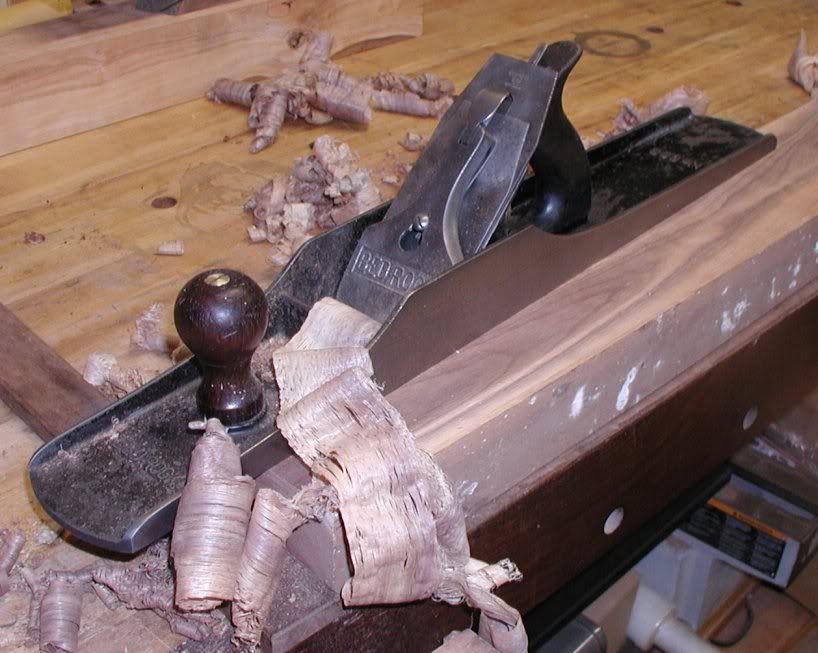I am considering buying one or the other. Please give me your reasons for preferring one over the other if you were to buy ONE of them. Thanks in advance!
I am considering buying one or the other. Please give me your reasons for preferring one over the other if you were to buy ONE of them. Thanks in advance!
$50. I'm buying the #7 and that's what it comes down to for me. I'm sure there are performance differences that other, wiser posters can speak to. But for me the truth is my skills won't capture any additional small performance capabilities offered by the #8 over the #7. And the #7, even with 20% off this week, is a financial reach for me.
Jeff,
I have the #7 just because I can interchange the frog and blades with my 4 1/2 and 5 1/2 (or #6). I keep the 45 degree in the 7, a 50 degree in the 5 1/2 and a 55 degree in the 4 1/2 for most smoothing chores. I have used the number 8, and will admit, I feel more manly using it.
Gary
Hmmm. Despite having a nice LV BU Jointer, there have been a few times where I've pulled out my first jointer - an Anant #8 - just because I thought the extra weight and length would help with the task at hand. I'd splurge and get the #8.
Use the fence Luke
I tried the LN #7 1/2 BU, the LN #7, and LN #8 at a hand tool event and preferred them in that order, with the #8 being the pick of the litter. The weight of the plane seems to help with flattening. I would love to hear what folks who have a #8 think. That being said I'm happy with my type 15 #7 Stanley and do not plan on buying a new jointer. If LN has one of these events near you try to attend -- they have the whole LN catalog of tools there to try out.
Last edited by Joel Goodman; 09-23-2009 at 7:00 PM.
The #7 is a little more versatile than the #8. If you're doing a lot of large work the size of large dining tables and front doors, then you might prefer the #8. If you're building furniture, then the #7 is a lot more handy. In conjunction with a shooting board, you can use the #7 down to a very small size.
Of all my metal planes, the LN #7 is hands-down my overall favorite; and it has nothing to do with it's purpose as a jointer or that it is a LN, but rather it is the one metal plane that feels like an extension of my body when I'm using it. No other metal plane feels as balanced in my hands. I have never held the LN #8.
This is one of those areas where my preferences of buying old used Stanley/Bailey planes has paid off, there is room in the budget for both.
For doing narrow board edges, the #7 is usually preferred. For doing the faces of boards it is the #8.
Being heavier and wider gives the #8 advantages at times, but it can also be a bit more of a work out.
Gary makes a good point if you want to have that kind of versatility.
As far as a shooting plane is concerned, my preference is for a LA BU plane. Currently my #65-1/2 is being used for this. Maybe one of these days I will spring for a bigger user for this task.
jim
"A pessimist sees the difficulty in every opportunity; an optimist sees the opportunity in every difficulty."
- Sir Winston Churchill (1874-1965)
While building my workbench I had to do a ton of flattening. Even though I have a hock setup for my #6/#7 I found myself loving my stanley #8 with the original blade/chipbreaker.
It's a little hard to really express, but for flattening panels I just found it was awesome. It's a little wider, longer, heavier and my #7 has been put to rest. Now if I go up from my #6 (my fav plane in my group) I just jump straight to the #8.
If I did it again I'd probably just skip the #7.
Last edited by Billy Chambless; 09-24-2009 at 7:43 AM.
“I don’t have a lot of tools because it doesn’t take many to make furniture.” - Rob Millard
If we're specifically talking about the Lie-Nielsen #7 and #8, the #7 has the option of putting a 50º or 55º high angle frog on it for those boards with squirrely grain. The #8 doesn't have this option.
I've tried both, and of the two, I'd rather have the #7. The added weight of the #8 didn't do much for me except to make me tired sooner.
If I really need a wide plane, I'll grab a Japanese plane, which has a 70mm wide blade (2-3/4"), which is even wider than the #8.
Joel,
I'm of a similar mindset. for most jointing tasks I reach for a No7 (my favorite is an old Union No7 I restored from scratch) or a Bedrock 606. But when it comes to flattening, I prefer my 608C. I'm not sure if it's the mass, or the balance, or maybe a secret "Bedrock" ingredient, but it works so damn well!

Dominic Greco
Jeff, if at all possible, you should try both out. The extra width and weight of an 8 means more effort per push. All the reasons that a 7 is more versatile are true. How likely we are to bother swapping out a 45 degree frog for a 50 remains to be seen.
And finally my answer - you don't want to hear, to the query which plane should you get:
Both. [only kidding]
Ken